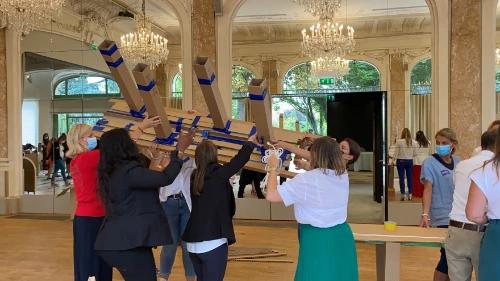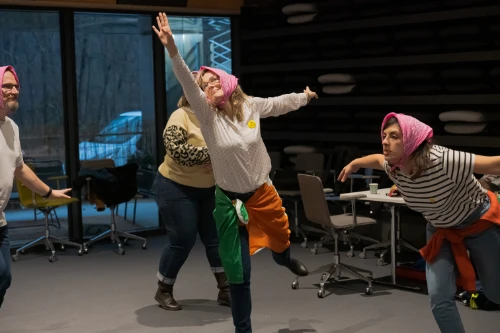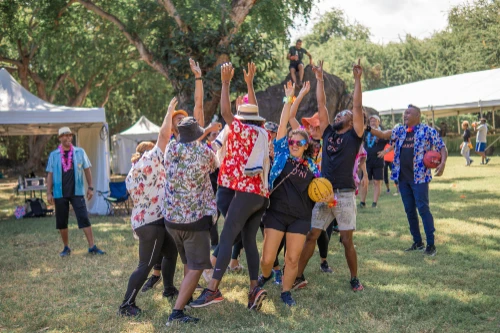Collaborative leadership: encouraging teams to take the initiative
Collaborative leadership transforms team dynamics. By involving every member of the team in decision-making and valuing ideas from the field, this model of management overturns traditional vertical practices. It's no longer just a question of leading, but of co-constructing an agile and responsible organisation, where commitment emerges naturally.

In this article, find out how you can stimulate initiative-taking, remove common obstacles and make your internal events a real driver of change.
What is collaborative leadership?
The most reliable definition of collaborative leadership is a managerial approach based on co-construction, trust and the active involvement of teams. Unlike a traditional hierarchical style where decisions come from above, it is based on the horizontal circulation of ideas, the valorisation of individual expertise and the search for a common goal.

This collaborative management style means that every member of the organisation is a player in the change process, participating in the discussions, the strategic choices and the solutions to be implemented.
The collaborative leader then becomes a facilitator: he or she leads, listens, clarifies the issues, but no longer centralises decision-making power.
This posture fosters sustainable collective intelligence, improves the quality of interactions and creates a framework for action that is better adapted to the complex and changing environments faced by every company today.
Why encourage collaborative leadership in business?
In a constantly changing professional world, collaborative leadership meets the growing need for agility, commitment and collective performance.
Here are two concrete effects observed in organisations that have adopted it:
Impact on collective performance
Teams that truly cooperate produce faster and better. According to a McKinsey study (2022), companies that encourage internal collaboration see their productivity increase fivefold. By integrating everyone's ideas and decompartmentalising roles, the collective becomes more effective in dealing with the unexpected and the complexities of everyday working life.

Employee commitment and empowerment
When employees feel that their ideas count, they become more involved. According to Gallup (2023), 77% of employees say they are more motivated when they are involved in decision-making. Collaborative leadership develops a strong sense of belonging, reinforces mutual trust and reduces turnover by making everyone a stakeholder in the collective success.
Obstacles to initiative-taking in teams
Even in companies that value collaboration, there are still obstacles to the spontaneous expression of ideas. The deeply rooted culture of control inhibits boldness. Many employees fear judgement or failure, especially if they have already been punished for taking initiatives that have not been validated. Others simply lack a framework that is conducive to speaking out, due to a lack of time or suitable forums for exchange. These obstacles hinder commitment and innovation.

They lead to a form of silent restraint: we do what we have to do, but we don't propose anything. To reverse this trend, the organisation needs to review its practices and create an environment of trust, where everyone feels entitled to express themselves.
How can internal events stimulate initiative?
The collective formats of corporate events, when they are well designed, can create fertile ground for freeing speech, initiating ideas and strengthening team dynamics.
Offering a framework of trust through participative workshops

Participative workshops during team buildings allow each member to speak without hierarchy, within a clear framework. This type of configuration stimulates initiative-taking, by encouraging mutual listening and reinforcing the cohesion of the group around a shared objective, without hierarchical pressure.
Encouraging active listening and collective creativity
A well-structured workshop based on active listening generates unexpected ideas. By feeling that they are being listened to, participants dare to propose, imagine and think outside the box. The collective dynamic stimulates the intelligence of the group, and strengthens the ability to work differently together.
Discover our team building activities
Encouraging the expression of talent in a fun environment
Playful formats break down professional barriers. When you play, you reveal yourself in a different way. This freedom of expression activates skills that are ignored on a day-to-day basis and encourages the emergence of new ideas, which can then be transposed into the working environment.

5 ideas for activities to encourage initiative-taking
Some collective experiences trigger more than just a moment of relaxation: they trigger things.
Here are five practical ways of encouraging autonomy and generating ideas in your teams:
Role-playing and decision-making simulations
Immersed in immersive scenarios such as Mission Secret Agents, Project Green City or the Immersive Quiz, participants have to make decisions under pressure, manage a situation and assume a role. This environment encourages them to express themselves and dare to make suggestions.
Escape games with team problem-solving

Playing a corporate escape game naturally encourages problem-solving, rapid communication and initiative-taking. Everyone contributes in real time to the group's progress, without waiting for top-down directives.
Creative group challenges

Creating a video, a restaurant or a fashion collection, as in an activity to create your own film, an activity to create your own restaurant or a styling workshop, stimulates the creativity of the group.ation workshop, stimulates concrete decision-making, role-sharing and spontaneity in a supportive environment.
Hackathons or innovation workshops
Divided into groups, participants co-construct a solution to a real problem within a given timeframe. This format encourages participants to take the initiative quickly, turn ideas into reality and create an action-oriented innovation dynamic.
Improvisation or pitch workshops
Expressing an idea out loud, defending it, improvising: these formats, such as a theatre workshop, an introductory slam workshop or a workshop to compose your company's anthem, unleash boldness, creativity and confidence.

Tips for integrating these practices into your corporate culture
For these one-off initiatives to become a real cultural lever, they need to be anchored in the long term and aligned with day-to-day management practices.
Repeating and ritualising co-construction moments
Organising an event once a year is not enough. It's the regular rituals (workshops, collective feedback, creative meetings) that establish a culture of active collaboration, where words flow and ideas take root naturally.

Training managers to be facilitators
A collaborative leader doesn't centralise, he or she facilitates. Training managers to be facilitators opens up the space for expression, asks the right questions and encourages listening, trust and experimentation on a daily basis.
Valuing ideas from the field
Every idea expressed deserves a response. By recognising contributions (even those that are not accepted), the company strengthens motivation and shows that individual initiative is not only tolerated, but expected and valued.
Collaborative leadership: a sustainable lever for commitment
By encouraging a management style based on listening and involving each collaborative leader in the implementation of a common objective, the company builds a working environment that is conducive to initiative, problem-solving and change management, even within its own teams.
Collaborative leadership is not just a new managerial strategy: it profoundly transforms the way in which responsibilities are shared, collaborative working is built and the diversity of talents is recognised.
It is a sustainable way of looking at the challenges of personal development, inclusion and organisational culture. For companies, it is also a concrete measure for engaging every employee in a collective, human and positive process, at every level of the workplace.

FAQ - Collaborative leadership
How do you measure the impact of collaborative leadership on team performance?
The impact can be measured by indicators such as the level of employee commitment, the frequency of initiatives proposed, the speed with which problems are resolved or the improvement in customer satisfaction. Regular internal surveys and analysis of the results of collective projects also provide a precise assessment.
What managerial practices should be avoided if collaborative leadership is to thrive?
It is essential to avoid micro-management, excessive centralisation of decisions and rigid control of initiatives. Discouraging mistakes such as failure can also inhibit initiative-taking. Managers must allow autonomy while providing a clear and benevolent framework.
What specific benefits does collaborative leadership bring in terms of innovation?
By valuing ideas from the field and the diversity of skills, collaborative leadership stimulates collective intelligence, generating more relevant innovations. This approach also speeds up the transition from reflection to action, with teams taking the initiative more spontaneously and assuming greater responsibility.


